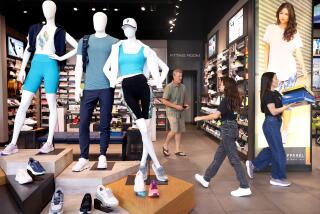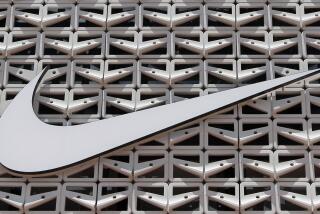Skechers Shares Plunge on Gloomy Forecast
- Share via
Investors unloaded shares of Skechers USA Inc. on Thursday after the shoemaker said it lost more than Wall Street was expecting in the fourth quarter and then gave a disappointing forecast for the first three months of this year.
The stock plunged 24%, losing $1.91 to close at $6.09, a 52-week low, on the New York Stock Exchange. Skechers’ shares have fallen 59% in the last year.
The Manhattan Beach company, which makes casual shoes and boots for men, women and children, lost $8.6 million, or 23 cents a share, for the quarter ended Dec. 31. That contrasts with a profit of $2 million, or 5 cents a share, in the same period in 2001.
Analysts surveyed by Thomson First Call were expecting a loss of 21 cents a share, which was based on previously lowered expectations.
Sales fell about 16% to $180.8 million, down from $214.1 million. Skechers blamed the decline, in part, on the sluggish economy, difficulties at West Coast ports and the shuttering of its mail order division in late 2001.
But it was Skechers’ downbeat prediction that it would earn 5 to 10 cents a share in the first quarter that surprised analysts, who were projecting per-share earnings of 31 cents. The company posted net income of 53 cents a share last year.
The company also said it expected first-quarter sales to be 15% to 20% below the same period last year.
The gloomy first-quarter outlook led some to fear that there’s still another shoe to drop. “Although they didn’t talk about the second quarter, I’ve got to believe it also is going to be ... difficult,” said Mitch Kummetz, an analyst with Wedbush Morgan Securities.
Although a weak economy is weighing on the footwear industry, a number of Skechers’ rivals managed to improve sales in the fourth quarter compared with the previous year, including Westlake Village-based K-Swiss Inc., Canton, Mass.-based Reebok International and Wolverine World Wide of Rockford, Mich.
Skechers, which generally offers lower-priced sneakers than many of its competitors, lost an edge in the last year when other companies began pushing simpler, so-called retro styles that were less expensive to make, Kummetz explained. As these rivals lowered their prices, consumers gravitated toward “authentic brands” such as Nike, Puma and Converse for retro shoes.
Further, although Skechers offers a wide range of shoes, it did not have a sizzling style to help drive sales last year, said John Zolidis, an analyst with Buckingham Research Group. By contrast, the company hit “a huge home run” in 2001 with its Energy sneaker, a distinctive style with a wavy reflective strip just above the sole, he said. “They haven’t found something to replace that, and consumers have moved on.”
Chief Executive David Weinberg said February sales have been “very encouraging.” But he acknowledged that retailers are more skittish about stocking up on inventory compared with last year, in part because of the threat of war with Iraq.
“They used to order 120 days out.... Now they like to order 90 days out, or less, if possible,” Weinberg said. “I think they’ve just become averse to any risk.”
Weinberg said he expects business in the second half of the year to be stronger, partly because of buyers’ positive initial response to its fall lineup.
“As to the magnitude of the growth, we’re leery about giving any guidance” for the second half of the year, he said, “because the company does not want to increase expectations.”
More to Read
Inside the business of entertainment
The Wide Shot brings you news, analysis and insights on everything from streaming wars to production — and what it all means for the future.
You may occasionally receive promotional content from the Los Angeles Times.










